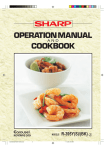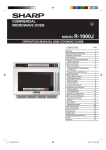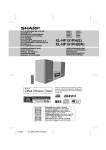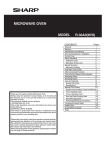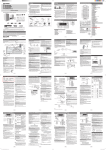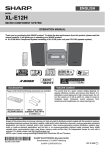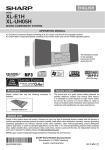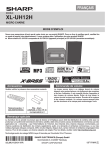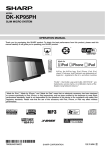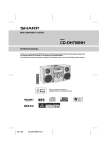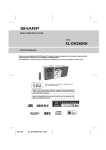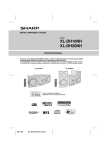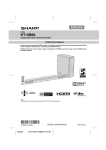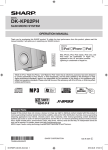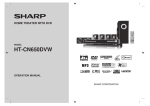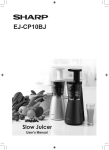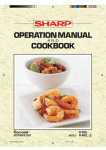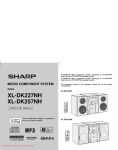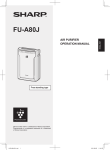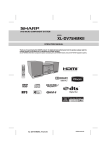Download Sharp XL-DAB151PH(S) Specifications
Transcript
HI FI COMPONENT SYSTEM MODEL XL-DAB151PH(S) XL-DAB151PH(BK) OPERATION MANUAL Thank you for purchasing this SHARP product. To obtain the best performance from this product, please read this manual carefully. It will guide you in operating your SHARP product. ● XL-DAB151PH(S) Hi Fi Component System consisting of XL-DAB151PH(S) (main unit) and CP-HF151H (speaker system). ● XL-DAB151PH(BK) Hi Fi Component System consisting of XL-DAB151PH(BK) (main unit) and CP-HF151H (speaker system). CD/USB RDS DAB iPhone, iPod, iPod classic, iPod nano, and iPod touch are trademarks of Apple Inc., registered in the U.S. and other countries. iPad is a trademark of Apple Inc. 11/8/2 XL-DAB151PH_Front_AUS.fm Special Notes Laser Diode Properties Material: AIGaAs Wavelength: 790 nm Emission Duration: continuous Laser Output: max. 0.7 mW WARNINGS ● When the ON/STAND-BY button is set at STAND-BY position, mains voltage is still present inside the unit. When the ON/STAND-BY button is set at STAND-BY position, the unit may be brought into operation by the timer mode or remote control. ● This unit contains no user serviceable parts. Never remove covers unless qualified to do so. This unit contains dangerous voltages, always remove mains plug from the socket before any service operation and when not in use for a long period. ● To prevent fire or shock hazard, do not expose this appliance to dripping or splashing. No objects filled with liquids, such as vases, shall be placed on the apparatus. ● Do not turn the volume on to full at switch on. Listen to music at moderate levels. Excessive sound pressure from earphones and headphones can cause hearing loss. Note for users in Australia: Copyright may exist in material you wish to record. Copying or broadcasting such material without permission of the relevant licensees or owners of the copyright is prohibited by law. SHARP is not in a position to authorise the copying or broadcasting of copyright materials and nothing in this OPERATION MANUAL should be implied as giving that authority. “Made for iPod,” “Made for iPhone,” and “Made for iPad” mean that an electronic accessory has been designed to connect specifically to iPod, iPhone, or iPad, respectively, and has been certified by the developer to meet Apple performance standards. Apple is not responsible for the operation of this device or its compliance with safety and regulatory standards. Please note that the use of this accessory with iPod, iPhone, or iPad may affect wireless performance. For other countries: Audio-visual material may consist of copyrighted works which must not be recorded without the authority of the owner of the copyright. Please refer to the relevant laws in your country. NOTE ● Recording and playback of any material may require consent, which SHARP is unable to give. Please refer particularly to the provisions of the Copyright Act 1956, the Dramatic and Musical Performers Protection Act 1958, the Performers Protection Acts 1963 and 1972 and to any subsequent statutory enactments and orders. CAUTION ● This product is classified as a CLASS 1 LASER product. ● Use of controls, adjustments or performance of procedures other than those specified herein may result in hazardous radiation exposure. As the laser beam used in this compact disc player is harmful to the eyes, do not attempt to disassemble the cabinet. Refer servicing to qualified personnel only. 2 11/8/3 01_XLDAB151PH EN_AUS.fm Special Note Supply of this product does not convey a license nor imply any right to distribute content created with this product in revenue-generating broadcast systems (terrestrial, satellite, cable and/or other distribution channels), revenue-generating streaming applications (via Internet, intranets and/or other networks), other revenue-generating content distribution systems (pay-audio or audio-on-demand applications and the like) or on revenue-generating physical media (compact discs, digital versatile discs, semiconductor chips, hard drives, memory cards and the like). An independent license for such use is required. For details, please visit http://mp3licensing.com MPEG Layer-3 audio coding technology licensed from Fraunhofer IIS and Thomson. Accessories The following accessories are included. Adaptors for iPhone x 3 Remote control x 1 “AA” size battery (UM/SUM-3, R6, HP-7 or similar) x 1 DAB/FM aerial x 1 AC power lead x 1 Stand for iPad x 1 CONTENTS Page Page General Information USB Precautions . . . . . . . . . . . . . . . . . . . . . . . . . . . . . . . . . . . 4 Controls and indicators . . . . . . . . . . . . . . . . . . . . . . . 4 - 5 Listening to USB mass storage device/MP3 player . . . . . . . . . . . . . . . . . . . . . . . . . . . . 15 Advanced USB playback . . . . . . . . . . . . . . . . . . . . . . . 16 Preparation for Use Radio System connections . . . . . . . . . . . . . . . . . . . . . . . . . 6 - 7 Remote control . . . . . . . . . . . . . . . . . . . . . . . . . . . . . . . . 7 Listening to the radio . . . . . . . . . . . . . . . . . . . . . . . 16 - 17 Using the Radio Data System (RDS) . . . . . . . . . 17 - 19 Listening to the DAB+ . . . . . . . . . . . . . . . . . . . . . . . . . 20 Changing the information display . . . . . . . . . . . . . . . . 21 Basic Operation General control . . . . . . . . . . . . . . . . . . . . . . . . . . . . . . . . 8 Setting the clock (Remote control only) . . . . . . . . . . . 8 - 9 Advanced Features iPod, iPhone and iPad Timer and sleep operation (Remote control only) . . . . . . . . . . . . . . . . . . . . . 22 - 23 Enhancing your system . . . . . . . . . . . . . . . . . . . . . . . . 24 Listening to the iPod, iPhone or iPad. . . . . . . . . . . . 9 - 11 CD or MP3/WMA disc Playback References Listening to a CD or MP3/WMA disc . . . . . . . . . . 11 - 12 Advanced CD or MP3/WMA disc playback . . . . . . 12 - 13 MP3/WMA folder mode (only for MP3/WMA files) . . . . . 14 Troubleshooting chart . . . . . . . . . . . . . . . . . . . . . . 24 - 25 Maintenance . . . . . . . . . . . . . . . . . . . . . . . . . . . . . . . . 25 Specifications . . . . . . . . . . . . . . . . . . . . . . . . . . . . . . . 26 3 11/8/3 01_XLDAB151PH EN_AUS.fm Precautions ■ ● Hold the AC power plug by the head when removing it from the wall socket, as pulling the lead can damage internal wires. ● The AC power plug is used as a disconnect device and shall always remain readily operable. ● Do not remove the outer cover, as this may result in electric shock. Refer internal service to your local SHARP service facility. ● The ventilation should not be impeded by covering the ventilation openings with items, such as newspapers, tablecloths, curtains, etc. ● No naked flame sources, such as lighted candles, should be placed on the apparatus. ● Attention should be drawn to the environmental aspects of battery disposal. ● This unit should only be used within the range of 5°C - 35°C (41°F - 95°F). Warning: The voltage used must be the same as that specified on this unit. Using this product with a higher voltage other than that which is specified is dangerous and may result in a fire or other type of accident causing damage. SHARP will not be held responsible for any damage resulting from use of this unit with a voltage other than that which is specified. General ● Please ensure that the equipment is positioned in a well ventilated area and ensure that there is at least 10 cm (4") of free space along the sides, top and back of the equipment. 10 cm (4") 10 cm (4") 10 cm (4") 10 cm (4") ● Use the unit on a firm, level surface free from vibration. ● Place the speakers at least 30 cm (12") away from any CRT TV to avoid colour variations across the TV screen. If the variations persist, move the speakers further away from the TV. LCD TV is not prone to such variation. ● Keep the unit away from direct sunlight, strong magnetic fields, excessive dust, humidity and electronic/electrical equipment (home computers, facsimiles, etc.) which generate electrical noise. ● Do not place anything on top of the unit. ● Do not expose the unit to moisture, to temperatures higher than 60°C (140°F) or to extremely low temperatures. ● If your system does not work properly, disconnect the AC power lead from the wall socket. Plug the AC power lead back in, and then turn on your system. ● In case of an electrical storm, unplug the unit for safety. ■ Volume control The sound level at a given volume setting depends on speaker efficiency, location, and various other factors. It is advisable to avoid exposure to high volume levels. Do not turn the volume on to full at switch on. Listen to music at moderate levels. Excessive sound pressure from earphones and headphones can cause hearing loss. Controls and indicators 1 2 3 5 6 7 4 8 ■ 9 10 11 12 13 14 15 Front panel Page 10. Headphone Socket. . . . . . . . . . . . . . . . . . . . . . . . 24 11. Tuner Preset Down, CD/USB Track Down, iPod/iPhone Skip Down . . . . . . . . . . . . . . . . . 11, 12 12. Tuner Preset Up, CD/USB Track Up, iPod/iPhone Skip Up . . . . . . . . . . . . . . . . . . . 11, 12 13. Disc/USB Stop Button . . . . . . . . . . . . . . . . . . . . . 12 14. Disc/USB/iPod/iPhone Play or Pause Button . . . . . . . . . . . . . . . . . . . . . . . . . 11, 12 15. Disc Tray Open/Close Button . . . . . . . . . . . . . . . 11 Page 1. Remote sensor . . . . . . . . . . . . . . . . . . . . . . . . . . . .7 2. Timer indicator . . . . . . . . . . . . . . . . . . . . . . . . . . .22 3. Disc Tray . . . . . . . . . . . . . . . . . . . . . . . . . . . . . . . .12 4. Docking Station for iPod or iPhone. . . . . . . . . . .10 5. Volume Control . . . . . . . . . . . . . . . . . . . . . . . . . . . .8 6. On/Stand-by Button . . . . . . . . . . . . . . .8, 10, 11, 16 7. FUNCTION Button . . . . . . . . . . . . . .8, 10, 11, 15, 15 8. USB Terminal. . . . . . . . . . . . . . . . . . . . . . . . . . . . .15 9. Audio In Socket . . . . . . . . . . . . . . . . . . . . . . . . . . .24 4 11/8/3 01_XLDAB151PH EN_AUS.fm Controls and indicators (continued) ■ 1 2 4 5 6 7 8 27 28 29 9 10 11 12 13 14 15 30 31 32 33 34 35 36 37 38 39 CD/USB RDS 16 DAB 17 1 23 4 Page 1. Remote Control Transmitter . . . . . . . . . . . . . . . . . . . . . 7 2. On/Stand-by Button. . . . . . . . . . . . . . . . . . . 8, 10, 11, 22 3. Numeric Buttons . . . . . . . . . . . . . . . . . . . . . . . . . . . . . 12 4. Bass/Treble Button . . . . . . . . . . . . . . . . . . . . . . . . . . . . 8 5. X-Bass Button . . . . . . . . . . . . . . . . . . . . . . . . . . . . . . . . 8 6. Tuning Down, Skip Down, Fast Reverse, Time Down Button . . . . . . . . . . . . . . . . . 8, 11, 14, 16, 22 7. Tuner Preset Up Button, iPod Cursor Up. . . . . . . . . . . . . . . . . . . . . . . . . 10, 15, 16 8. Volume Down Button. . . . . . . . . . . . . . . . . . . . . . . . . . . 8 9. Folder Button . . . . . . . . . . . . . . . . . . . . . . . . . . . . . 14, 15 10. Tuner Preset Down Button, iPod Cursor Down . . . . . . . . . . . . . . . . . . . . . . 10, 15, 16 11. CD Button . . . . . . . . . . . . . . . . . . . . . . . . . . . . . . . . . . . 11 12. USB Button . . . . . . . . . . . . . . . . . . . . . . . . . . . . . . . . . 15 13. iPod Button . . . . . . . . . . . . . . . . . . . . . . . . . . . . . . . . . 10 14. iPod Display (TV OUT) Button . . . . . . . . . . . . . . . . . . 10 15. CD/USB Display Button. . . . . . . . . . . . . . . . . . . . . 14, 15 16. RDS ASPM Button . . . . . . . . . . . . . . . . . . . . . . . . . . . 17 17. DAB SCAN Button . . . . . . . . . . . . . . . . . . . . . . . . . . . . 20 18. Open/Close Button . . . . . . . . . . . . . . . . . . . . . . . . . . . 11 19. Memory Button . . . . . . . . . . . . . . . . . . . . . . . . . . . 12, 16 20. Clear Button . . . . . . . . . . . . . . . . . . . . . . . . . . . . . . . . . 13 21. Clock/Timer Button . . . . . . . . . . . . . . . . . . . . . . . . . 8, 22 22. Sleep Button. . . . . . . . . . . . . . . . . . . . . . . . . . . . . . . . . 23 23. Repeat Button . . . . . . . . . . . . . . . . . . . . . . . . . . . . . . . 12 24. Mute Button . . . . . . . . . . . . . . . . . . . . . . . . . . . . . . . . . . 8 25. Random Button . . . . . . . . . . . . . . . . . . . . . . . . . . . . . . 13 26. Tuning Up, Skip Up, Fast Forward, Time Up Button . . . . . . . . . . . . . . . . . . . 8, 11, 14, 16, 22 27. Volume Up Button . . . . . . . . . . . . . . . . . . . . . . . . . . . . . 8 28. Enter Button . . . . . . . . . . . . . . . . . . . . . . . . . . . . 8, 15, 22 29. Demo/Dimmer Button . . . . . . . . . . . . . . . . . . . . . . . . 6, 8 30. Audio/Line (INPUT) Button . . . . . . . . . . . . . . . . . . . 7, 24 31. Tuner/DAB Button . . . . . . . . . . . . . . . . . . . . . . . . . . . . 16 32. iPod Play/Pause Button. . . . . . . . . . . . . . . . . . . . . . . . 10 33. iPod Menu Button . . . . . . . . . . . . . . . . . . . . . . . . . . . . 10 34. CD/USB Play/Pause Button. . . . . . . . . . . . . . . 11, 12, 15 35. CD/USB Stop Button . . . . . . . . . . . . . . . . . . . 11, 12, 15 36. RDS Display Button . . . . . . . . . . . . . . . . . . . . . . . . . . 17 37. RDS PTY Button. . . . . . . . . . . . . . . . . . . . . . . . . . . . . . 17 38. DAB Display Button. . . . . . . . . . . . . . . . . . . . . . . . . . . 20 39. DAB Enter Button . . . . . . . . . . . . . . . . . . . . . . . . . . . . 20 18 19 20 21 22 23 24 25 26 3 5 6 16 17 18 19 20 7 8 9 21 10 12 14 11 13 15 22 23 24 25 Remote control ■ 26 27 28 Display Page 1. USB Indicator . . . . . . . . . . . . . . . . . . . . . . . . . . . . . . . .15 + ■ 1. 2. 3. 4. 2. iPod Indicators . . . . . . . . . . . . . . . . . . . . . . . . . . . . . . .10 3. CD Indicator . . . . . . . . . . . . . . . . . . . . . . . . . . . . . . . . .12 4. DAB+ Indicator. . . . . . . . . . . . . . . . . . . . . . . . . . . . . . .20 5. MP3 Indicator . . . . . . . . . . . . . . . . . . . . . . . . . . . . . . . .13 6. WMA Indicator . . . . . . . . . . . . . . . . . . . . . . . . . . . . . . .13 7. RDM (Random) Indicator. . . . . . . . . . . . . . . . . . . . . . .13 8. MEM (Memory) Indicator . . . . . . . . . . . . . . . . . . . . . . .13 9. Repeat Indicator. . . . . . . . . . . . . . . . . . . . . . . . . . . . . .12 10. Play/Pause Indicator . . . . . . . . . . . . . . . . . . . . . . . . . . 12 11. Tuning FM Indicator. . . . . . . . . . . . . . . . . . . . . . . . . . . 16 12. FM Stereo Mode Indicator. . . . . . . . . . . . . . . . . . . . . . 16 13. Stereo Station Indicator . . . . . . . . . . . . . . . . . . . . . . . 16 14. RDS Indicator . . . . . . . . . . . . . . . . . . . . . . . . . . . . . . . . 17 15. PTY Indicator . . . . . . . . . . . . . . . . . . . . . . . . . . . . . . . . 17 16. Muting Indicator. . . . . . . . . . . . . . . . . . . . . . . . . . . . . . . 8 17. X-bass Indicator. . . . . . . . . . . . . . . . . . . . . . . . . . . . . . . 8 18. Title Indicator . . . . . . . . . . . . . . . . . . . . . . . . . . . . . . . . 14 19. Artist Indicator . . . . . . . . . . . . . . . . . . . . . . . . . . . . . . . 14 20. Folder Indicator . . . . . . . . . . . . . . . . . . . . . . . . . . . . . . 14 21. Album Indicator . . . . . . . . . . . . . . . . . . . . . . . . . . . . . . 14 22. File Indicator . . . . . . . . . . . . . . . . . . . . . . . . . . . . . . . . 14 23. Track Indicator . . . . . . . . . . . . . . . . . . . . . . . . . . . . . . . 14 24. Daily Timer Indicator . . . . . . . . . . . . . . . . . . . . . . . . . . 22 25. Once Timer Indicator. . . . . . . . . . . . . . . . . . . . . . . . . . 22 26. Disc Indicator . . . . . . . . . . . . . . . . . . . . . . . . . . . . . . . . 12 27. Total Indicator . . . . . . . . . . . . . . . . . . . . . . . . . . . . . . . 14 28. Sleep Indicator . . . . . . . . . . . . . . . . . . . . . . . . . . . . . . . 23 Speaker system Tweeter Woofer Bass Reflex Duct Speaker Wire 1 3 2 4 ■ Speaker grilles are removable Make sure nothing comes into contact with the speaker diaphragms when you remove the speaker grilles. 5 11/8/3 01_XLDAB151PH EN_AUS.fm System connections Make sure to unplug the AC power lead before making any connections. Right speaker Video cable (not supplied) DAB/FM aerial TV To video input socket Left speaker RED BLACK Wall socket (AC 220 - 240 V ~ 50/60 Hz) MODEL NO. XL-DAB151PH(S) HI FI COMPONENT SYSTEM AC 220 - 240V 50/60Hz 45W FREQUENCY RANGE : FM 87.5 - 108 MHz DAB 174.928 - 239.200 MHz Label is located at the bottom of the unit. SERIAL NO. MADE IN CHINA 92Lxxxxxxxxxxx ■ ■ Aerial connection Supplied DAB/FM aerial: Connect the DAB/FM aerial wire to the DAB/FM terminal and position the DAB/FM aerial wire in the direction where the strongest signal can be received. Note: Placing the aerial on the unit or near the AC power lead may cause noise pickup. Place the aerial away from the unit for better reception. ■ Speaker connection ● Connect the black wire to the minus (–) terminal, and the red wire to the plus (+) terminal. ● Use speakers with an impedance of 4 ohms or more, as lower impedance speakers can damage the unit. ● Do not mistake the right and the Incorrect left channels. The right speaker is the one on the right side when you face the unit. ● Do not let the bare speaker wires touch each other. ● Do not allow any objects to fall into or to be placed in the bass reflex ducts. ● Do not stand or sit on the speakers. You may be injured. ■ 01_XLDAB151PH EN_AUS.fm Connecting iPod or iPhone to TV Photo and video files from iPod or iPhone can be viewed by connecting the system to TV/monitor. If the TV/monitor has a video input, connect it to the VIDEO OUT socket at the back of the unit and set the TV Out on the iPod or iPhone unit to “ON” position. Note: Please make sure to set iPod unit to either NTSC or PAL to match your TV signal. Please visit Apple’s homepage for further information. 6 11/8/3 Demonstration mode ● The first time the unit is plugged in, the unit will enter the demonstration mode. ● To cancel the demonstration mode, press the DEMO/ DIMMER button (remote control) during power standby mode. The unit will enter the low power consumption mode. ● If iPod or iPhone is docked, the unit will begin charging. “Charge Mode” will be displayed. Demonstration mode is invalid during charge mode. ● To return to the demonstration mode, press the DEMO/ DIMMER button again. System connections (continued) Remote control ■ ■ AC power connection Battery installation After checking all the connections have been made correctly, plug the AC power lead of this unit into the wall socket. 1 Open the battery cover. 2 Insert the supplied battery according to the direction Note: Unplug the AC power lead from the wall socket if the unit will not be in use for a prolonged period of time. indicated in the battery compartment. When inserting or removing the battery, push it towards the (–) battery terminals. 3 Close the cover. ■ Line input connection (TV, etc.) Connect to the TV using an audio cable. TV To audio output sockets Caution: ● Remove the battery if the unit will not be used for a long period of time. This will prevent potential damage due to battery leakage. ● Do not use rechargeable battery (nickel-cadmium battery, etc.). ● Installing the battery incorrectly may cause the unit to malfunction. ● Batteries (battery pack or batteries installed) shall not be exposed to excessive heat such as sunshine, fire or the like. Notes concerning use: ● Replace the battery if the operating distance is reduced or if the operation becomes erratic. Purchase a “AA” size battery (UM/SUM-3, R6, HP-7 or similar). ● Periodically clean the transmitter on the remote control and the sensor on the unit with a soft cloth. ● Exposing the sensor on the unit to strong light may interfere with operation. Change the lighting or the direction of the unit if this occurs. ● Keep the remote control away from moisture, heat, shock, and vibrations. Audio cable (commercially available) Audio signal Main unit To LINE input sockets ■ Test of the remote control Check the remote control after checking all the connections. Point the remote control directly at the remote sensor on the unit. The remote control can be used within the range shown below: To select Line In function: ● On main unit: Press FUNCTION button repeatedly until Line In is displayed. ● On remote control: Press AUDIO/LINE (INPUT) button repeatedly until Line In is displayed. Remote sensor 0.2 m - 6 m (8" - 20' ) CD/USB RDS DAB 7 11/8/3 01_XLDAB151PH EN_AUS.fm General control ■ Bass control 1 Press the BASS/TREBLE button to select “Bass”. 2 Within 5 seconds, press the VOLUME (+ or –) button to adjust the bass. - 5 ↔ - 4........↔ + 4 ↔ + 5 ■ Treble control 1 Press the BASS/TREBLE button to select “Treble”. 2 Within 5 seconds, press the VOLUME (+ or –) button to adjust the CD/USB RDS DAB treble. ■ To turn the power on - 5 ↔ - 4........↔ + 4 ↔ + 5 Press the ON/STAND-BY button to turn the power on. After use: Press the ON/STAND-BY button to enter the power stand-by mode. ■ ■ Function When the FUNCTION button on main unit is pressed, the current function will change to different mode. Press the FUNCTION button repeatedly to select desired function. Display brightness control To dim the display brightness, press the DEMO/DIMMER button on the remote control. CD (Display is dim). Dimmer 2 (Display gets dimmer). Dimmer off (Display is bright). FM STEREO FM MONO Dimmer 1 ■ DAB Line In Volume auto set-in Volume control Setting the clock (Remote control only) Turn the volume knob towards VOLUME +/– (on main unit) or press VOL +/– (on remote control) to increase or decrease the volume. ■ Audio In USB Note: The backup function will protect the memorised function mode for a few hours should there be a power failure or the AC power lead becomes disconnected. If you turn off and on the main unit with the volume set to 17 or higher, the volume starts at 16. ■ iPod Auto power on function When you press any of the following buttons, the unit turns on. ● iPod, CD, USB, AUDIO / LINE (INPUT), TUNER/DAB on the remote control: Selected function is activated. ● / button on the main unit: The unit turns on and playback of the last function will start (CD, TUNER/DAB, USB, iPod, AUDIO IN, LINE IN) ■ Auto power off function The main unit will enter the stand-by mode (when iPod or iPhone is not docked) after 15 minutes of inactivity during: iPod: No connection. AUDIO IN / LINE IN: No detection of input signal or very low sound audibility. CD / USB: In the stop mode. Note: However, if iPod or iPhone is docked, the unit will begin charging. “Charge Mode” will be displayed during standby mode. ■ CD/USB RDS DAB In this example, the clock is set for the 24-hour (00:00) display. 1 Press the ON/STAND-BY button to turn the power on. 2 Press the CLOCK/TIMER button. 3 Within 10 seconds, press the ENTER button. To adjust the day, Muting press the or button and then press the ENTER button. 4 Press the or button to select 24-hour or 12-hour display and then press the ENTER button. The volume is muted temporarily when pressing the MUTE button on the remote control. Press again to restore the volume. ■ X-Bass control The 24-hour display will appear. (00:00 - 23:59) When the power is first turned on, the unit will enter the extra bass mode which emphasises the bass frequencies, and “X-BASS” will appear. To cancel the extra bass mode, press the X-BASS button on the remote control. The 12-hour display will appear. (AM 12:00 - PM 11:59) 8 11/8/3 01_XLDAB151PH EN_AUS.fm Setting the clock (Remote control only) (continued) ■ iPod, iPhone and iPad connection (USB only) 1 Insert the connector to the iPod, iPhone or iPad. 5 To adjust the hour, press the or button or and then press the ENTER button. Press the button once to advance the time by 1 hour. Hold it down to advance continuously. 6 To adjust the minutes, press the or button or and then press the ENTER button. Press the button once to advance the time by 1 minute. To confirm the time display: Press the CLOCK/TIMER button. The time display will appear for about 5 seconds. iPad Connector Note: When power supply is restored after unit is plugged in again or after a power failure, reset the clock (pages 8 - 9). To readjust the clock: Perform “Setting the clock” from step 2. 2 Place the iPad to the stand for iPad. iPad To change the 24-hour or 12-hour display: Perform “Setting the clock” from step 2 onwards. Stand for iPad Listening to the iPod, iPhone or iPad Made for: ● iPod touch (4th generation) ● iPod touch (3rd generation) ● iPod touch (2nd generation) ● iPod touch (1st generation) ● iPod classic ● iPod nano (6th generation) ● iPod nano (5th generation) ● iPod nano (4th generation) ● iPod nano (3rd generation) ● iPod nano (2nd generation) ● iPhone 4 ● iPhone 3GS ● iPhone 3G ● iPhone ● iPad Caution: Please update your iPod, iPhone and iPad unit to the latest software version before using it. Please visit Apple’s homepage to download the latest version for your iPod, iPhone and iPad. Notes: ● Charging terminal for iPod, iPhone and iPad: Condition DOCK USB USB function NO YES Other function YES NO Stand-by YES NO 3 Connect the iPod, iPhone or iPad to the unit via USB connector. USB Note: USB terminal do not support VIDEO out. ■ iPod, iPhone or iPad playback 1 Press the ON/STAND-BY button to turn the power on. 2 Press the USB button on the remote control or FUNCTION button repeatedly on the main unit to select USB function. 3 Connect iPod, iPhone or iPad to the unit. “USB/iPod” will appear. 4 Press the / (CD/USB ● The message “This accessory is not made to work with iPhone” or similar, may appear on the iPhone screen when: - battery is low. - the iPhone is not properly docked (eg. slanting). If this occurs, remove and re-dock the iPhone. ● This product is made for iPhone. To prevent random interference when iPhone is docked, the headphone output is disabled, and “HP INVALID” will be displayed. You may also experience brief audio interference during incoming calls. ■ 01_XLDAB151PH EN_AUS.fm iPod and iPhone connection (Dock only) Note: Docking station is not recommended for iPad connection. Adaptor for iPod and iPhone connection Notes: ● Please use the adaptor supplied with your iPod or iPhone unit. ● You can use an audio cable to connect your iPod to the AUDIO IN socket if: 1. your iPod adaptor does not fit into the iPod dock on the main unit. 2. you have an iPod that does not have an iPod adaptor. 3. you have an iPod that does not have an iPod 30 pin connector. 9 11/8/3 / ) button to start playback. Note: Stop button ( ) is invalid during iPod, iPhone or iPad playback. Listening to the iPod, iPhone or iPad (continued) Adaptor No. 12 15 15 19 ■ iPhone Description iPhone iPhone 3G iPhone 3GS iPhone 4 Capacity 4GB & 8GB & 16GB 8GB & 16GB 16GB & 32GB 16GB & 32GB To insert adaptor for iPod or iPhone 1 Open the docking station for iPod and iPhone by pulling up. CD/USB RDS DAB 2 Insert the adaptor for iPod and iPhone into unit and ■ connect your iPod or iPhone. iPhone (bottom) iPhone playback ● Sound will only switch from iPhone to the main unit after authentication process is completed in approximately 10 seconds. ● Incoming calls will pause the playback. ● Once the calls are answered, the conversation can only be heard through the built-in iPhone speaker. Turn on the iPhone speaker or undock the iPhone to start conversation. iPhone Dock connector Adaptor for iPhone ■ To disconnect iPod, iPhone or iPad Simply remove the iPod or iPhone from the docking station or iPad from USB terminal. It is safe to do so even during playback. Dock for iPhone Connector for iPhone ■ Watching videos on a TV connected to iPod or iPhone Caution: Unplug all accessories from the iPod or iPhone before inserting it into the dock. 1 Press the DISPLAY (TV OUT) button for more than 2 ■ 2 Press the ENTER button to start playback. seconds. “TV Display” will appear on display. To remove adaptor for iPod or iPhone Insert the tip of a screwdriver (“–” type, small) into the adaptor hole as shown and lift upward to remove. ■ Notes: ● If the TV Out setting is already turned on at video menu, the video is automatically displayed on the TV screen when ENTER key is pressed. ● TV out display is not support through USB terminal. (iPad) ● To return to watching video on iPod or iPhone screen, press the MENU button to enter video menu. Then press the DISPLAY (TV OUT) button for more than 2 seconds until “iPod Display” appears. ● During iPod or iPhone video playback, pressing the DISPLAY (TV OUT) button will not toggle video out display between iPod and TV. iPod or iPhone playback 1 Press the ON/STAND-BY button to turn the power on. 2 Press the iPod button on the remote control or FUNCTION button repeatedly on the main unit to select iPod function. 3 Insert iPod or iPhone unit in iPod dock of main unit. “Dock Ok” will appear. 4 Press the / (iPod Caution: ● Unplug all accessories for the iPod or iPhone before inserting it into the docking station. ● Stop button ( ) at main unit is invalid during iPod function. / ) button to start playback. 10 11/8/3 01_XLDAB151PH EN_AUS.fm Listening to the iPod, iPhone or iPad (continued) ■ Navigating the iPod, iPhone or iPad menus Function Main unit Dock/USB Remote control Dock USB iPod iPod ____ Enter ____ Press to confirm the selection. Cursor Up/Down ____ Press to select in the iPod menu. 1 Press the iPod MENU button to view the menu on iPod, iPhone or iPad unit. Press it again to go back to previous menu. 2 Use the PRESET ( or ) button to select an item on the menu and then press ENTER button. Note: When navigating the iPod, iPhone or iPad menu with remote control, do not operate any of the buttons on the iPod or iPhone unit. The volume level is adjusted by pressing the VOL (+ or –) button on the main unit or the remote control. Adjusting the volume on the iPod, iPhone or iPad units give no effect. Operation Menu Press to view the iPod menu during iPod function. Listening to a CD or MP3/WMA disc iPod, iPhone and iPad operations: The operations described below depend on the generation iPod , iPhone and iPad you are using. System on operation: When the main unit is powered on, the iPod, iPhone or iPad units will automatically power on when docked or connected in the unit. System off (stand-by operation): When the main unit is turned to stand-by mode, the docked iPod, iPhone or connected iPad unit will automatically turn to stand-by mode. ■ Various iPod, iPhone and iPad functions Function Main unit Dock/USB Play Remote control Dock USB iPod CD/USB iPod Pause CD/USB Track up/ down Fast forward/ reverse ____ Operation CD/USB Press in the pause mode. DAB Press in the playback mode. Press in the playback or pause mode. If you press the button in the pause mode, press the / button to start the desired track. Press and hold down in the playback mode. Release the button to resume playback. Press for more than 2 seconds to toggle the video out display between iPod or TV. TV Display ____ Repeat ____ Press to toggle repeat mode. Shuffle ____ Press to toggle shuffle mode. iPod RDS This system can play back a standard CD, CD-R/RW in the CD format and CD-R/RW with MP3 or WMA files, but cannot record on them. Some audio CD-R and CD-RW discs may not be playable due to the state of the disc or the device that was used for recording. MP3: MP3 is a form of compression. It is an acronym which stands for MPEG Audio Layer 3. MP3 is a type of audio code which is processed by significant compression from the original audio source with very little loss in sound quality. ● This system supports MPEG 1 Layer 3 and VBR files. ● During VBR file playback, time counter in the display may differ from its actual playback time. ● Bitrate which is supported by MP3 is 32 ~ 320 kbps. WMA: WMA files are Advanced System Format files that include audio files which are compressed with Windows Media Audio codec. WMA is developed by Microsoft as an audio format file for Windows Media Player. ● “MP3” and “WMA” indicator will light up after the unit reads information on an MP3 or WMA disc. ● Bitrate which is supported by WMA is 64 ~ 160 kbps. ■ Disc playback 1 Press the ON/STAND-BY button to turn the power on. 2 Press the CD button on the remote control or FUNCTION button repeatedly on the main unit to select CD function. 3 Press the OPEN/CLOSE button to open the disc tray. 4 Place the disc on the disc tray, label side up. 11 11/8/3 01_XLDAB151PH EN_AUS.fm Listening to a CD or MP3/WMA disc Advanced CD or MP3/WMA disc playback (continued) 5 Press the OPEN/CLOSE button to close the disc tray. 6 Press the / (CD/USB / ) button to start playback. After CD/USB RDS the last track is played, the unit will stop automatically. DAB Caution: ● Do not place two discs in one disc tray. ● Do not play discs of special shapes (heart, octagon, etc). It may cause malfunctions. ● Do not push the disc tray whilst it is moving. ● If the power fails whilst the tray is open, wait until the power is restored. ● If TV or radio interference occurs during CD operation, move the unit away from the TV or radio. ● Be sure to place 8 cm (3") disc in the middle of the disc tray. ● Due to the structure of the disc information, it takes longer to read an MP3/WMA disc than a normal CD (approximately 20 to 90 seconds). Notes for CD or MP3/WMA disc: Rewritable multi-session discs with unfinished writing, can still be played. ■ ■ Direct track search By using the Numeric buttons, the desired tracks on the current disc can be played. Use the Numeric buttons on the remote control to select the desired track whilst playing the selected disc. ● The Numeric buttons allow you to select up to number 9. ● When selecting number 10 or higher, use the “10+” button. A. For example, to choose 13 1 Press the “10+” button once. 2 Press the “1” button. 3 Press the “3” button. Selected track number B. For example, to choose 130 Various disc functions Function Play Stop Pause Track up/ down Fast forward/ reverse Main unit Remote control CD/USB CD/USB CD/USB 1 2 3 4 Operation Press in the stop mode. Press the “10+” button twice. Press the “1” button. Press the “3” button. Press the “0” button. Notes: ● A track number higher than the number of tracks on the disc cannot be selected. ● During random play, direct search is not possible. To stop playback: Press the (CD/USB ) button. Press in the playback mode. Press in the playback mode. Press the / button to resume playback from the paused point. Press in the playback or stop mode. If you press the button in the stop mode, press the / button to start the desired track. Press and hold down in the playback mode. Release the button to resume playback. ■ Repeat play Repeat play can play one track, all tracks or a programmed sequence continuously. To repeat one track: Press the REPEAT button repeatedly until “Repeat One” appears. Press the / (CD/USB / ) button. To repeat all tracks: Press the REPEAT button repeatedly until “Repeat All” appears. Press the / (CD/USB / ) button. To repeat desired tracks: Perform steps 1 - 5 in “Programmed play” section on next page and then press the REPEAT button repeatedly until “Repeat All” appears. To cancel repeat play: Press the REPEAT button repeatedly until “ ” disappears. Caution: After performing repeat play, be sure to press the (CD/ USB ) button. Otherwise, the disc will play continuously. Note: During repeat play, random play is not possible. 12 11/8/3 01_XLDAB151PH EN_AUS.fm Advanced CD or MP3/WMA disc playback (continued) ■ ■ Random play The tracks on the disc can be played in random order automatically. To random play all tracks: Press RANDOM button on the remote control until “Random” appears. Press the / (CD/USB / ) button. To cancel random play: Press the RANDOM button until “RDM” indicator disappears. Notes: ● If you press the button during random play, you can move to the track selected next by the random operation. On the other hand, the button does not allow you to move to the previous track. The beginning of the track being played will be located. ● In random play, the unit will select and play tracks automatically. (You cannot select the order of the tracks.) ● During random play, repeat play is not possible. ■ Programmed play (MP3/WMA) 1 Whilst in the stop mode, press the MEMORY button to enter the programming save mode. 2 Press the PRESET ( or ) button on the remote control to select the desired folder. or button on the remote Then press the control to select the desired tracks. 3 Press the MEMORY button to save the folder and track number. Programmed play (CD) You can choose up to 32 selections for playback in the order you like. 4 Repeat steps 2 – 3 for other folder/tracks. Up to 32 tracks can be programmed. 5 Press the / (CD/USB / ) button to start playback. 1 Whilst in the stop mode, press the MEMORY button on the remote control to enter the programming save mode. To cancel the programmed play mode: During programmed stop mode, press the (CD/USB ) button. The display will show “Memory Clear” and all the programmed contents will be cleared. 2 Press the or buttons on the remote control to select the desired track. Selected track number 3 Press the MEMORY button to save the track number. 4 Repeat steps 2 - 3 for other tracks. Up to 32 tracks can be programmed. If you want to check the programmed tracks, press the MEMORY button repeatedly. If you make a mistake, the programmed tracks can be cleared by pressing the CLEAR button. 5 Press the / (CD/USB / ) button to start playback. 13 11/8/3 01_XLDAB151PH EN_AUS.fm Adding tracks to the programme: If a programme has been previously stored, the “MEM” indicator will be displayed. Press the MEMORY button. Then follow steps 2 - 3 to add tracks. Notes: ● When a disc is ejected, the programme is automatically cancelled. ● If you press the ON/STAND-BY button to enter the stand-by mode or change the function from CD to another, the programmed selections will be cleared. ● During the programme operation, random play is not possible. MP3/WMA folder mode (only for MP3/WMA files) To play back MP3/WMA (Windows Media Audio) file There are many music sites on the internet that you can download MP3/WMA (Windows Media Audio) music files. Follow the instructions from the website on how to download the music files. You can then play back these downloaded music files by burning them to a CD-R/RW disc. ● Your downloaded song/files are for personal use only. Any other usage of the song without owner’s permission, is against the law. CD/USB RDS DAB ■ About folder playback order If MP3/WMA files are recorded in several folders, a folder number will be set to each folder automatically. These folders can be selected by the FOLDER button on the remote control. If there is no supported file formats inside the selected folder, the folder is skipped and the next folder will be selected. Example: How to set folder number if MP3/WMA format files are recorded as below figure. ■ Procedure to playback MP3/WMA disc with folder mode on To play back CD-R/RW. 1 Press the CD button, and load an MP3/WMA disc. Press the FOLDER button and disc info will be displayed. 1 ROOT folder is set as folder 1. MP3 indicator WMA indicator 2 As for folders inside ROOT folder (Folder A and Folder TOTAL indicator B), the folder which is recorded earlier on the disc will be set as folder 2 and folder 3. 3 As for folder inside Folder A (Folder C and Folder D), the Total number of folder folder which is recorded earlier on the disc will be set as folder 4 and folder 5. or ) button to select desired playback folder. (Folder mode on) 4 Folder E that is inside Folder D will be set as folder 6. FOLDER indicator ● The folder and file order information which is recorded on the disc depends on the writing software. There maybe possibilities that this unit will playback the files not according to our expected playback order. ● For CD MP3/WMA, 99 numbers of folders and 999 files inclusive of the folders which have non playable files can be read. FOLDER number FOLDER A (FOLDER 2) FOLDER C (FOLDER 4) FOLDER D (FOLDER 5) FOLDER B (FOLDER 3) FILE 3 FILE 4 FILE 5 FILE 6 FILE 7 FILE 8 FOLDER E (FOLDER 6) First track number in the folder 3 Select desired file to be played back by pressing the Folder mode on/off can be operated by the FOLDER button on the remote control. Files that are played when folder mode is set to the on position, may differ from those played back when folder mode is turned off. ROOT (FOLDER 1) Total number of files 2 Press the PRESET ( or button. 4 Press the / (CD/USB / ) button. Playback will start and file name will be displayed. ● Title, Artist and Album name are displayed if they are recorded on the disc. ● In case of playback with the folder mode on, press the PRESET ( or ) button, and the folder can be selected even though it is in playback/pause mode. It will continue playback/pause mode in the 1st track of the selected folder. ● Display content can be changed by pressing the CD/ USB DISPLAY button. FILE 9 FILE 10 File name display FILE 1 FILE 2 Counter display Album display Folder display Title display Artist display Note: If “Not Supported” is displayed, it means “Copyright protected WMA file” or “Not supported playback file” is selected. 14 11/8/3 01_XLDAB151PH EN_AUS.fm Listening to USB mass storage device/MP3 player 2 Press the FOLDER button, and press the PRESET ( or ) button to select desired playback folder. To start playback with folder mode on, go to step 4. To change the playback folder, press the PRESET ( or ) button to select another folder. 3 Select desired file to be played back by pressing the or button. 4 Press the / (CD/USB / ) button. Playback will start and the file name will be displayed. ● Title, Artist and Album name are displayed if they are recorded in the USB memory device. ● Display content can be changed by pressing the CD/ USB DISPLAY button. ■ CD/USB RDS To remove USB memory device DAB 1 Press the Note: This product is not compatible with MTP and AAC file systems from USB mass storage device or MP3 player. ■ (CD/USB ) button to stop playback. 2 Disconnect USB memory device from the USB terminal. To play back USB/MP3 player with folder mode off 1 Press the USB button on the remote control or FUNCTION button repeatedly on main unit to select USB function. Connect the USB memory device that has MP3/WMA format files on the unit. When the USB memory is connected to the main unit, the device information will be displayed. 2 Select desired file to be played back by pressing the or button. 3 Press the / (CD/USB / ) button. Playback will start and the file name will be displayed. ● Title, Artist and Album name are displayed if they are recorded in the USB memory device. ● Display content can be changed by pressing the CD/USB DISPLAY button. Note: To pause playback: Press the / (CD/USB ■ / ) button. To play back USB/MP3 player with folder mode on 1 Press the USB button on the remote control or FUNCTION button repeatedly on main unit to select USB function. Connect the USB memory device that has MP3/WMA format files on the unit. When the USB memory is connected to the main unit, the device information will be displayed. 15 11/8/3 01_XLDAB151PH EN_AUS.fm Notes: ● SHARP will not be held liable for the loss of data whilst the USB memory device is connected to the audio system. ● Files compressed in MP3 and/or WMA format can be played back when connected to the USB terminal. ● This USB memory’s format supports FAT 16 or FAT 32. ● SHARP cannot guarantee that all USB memory devices will work on this audio system. ● USB cable is not recommended for use in this audio system to connect to USB memory device. Use of the USB cable will affect the performance of this audio system. ● This USB memory cannot be operated via USB hub. ● The USB terminal in this unit is not intended for a PC connection but is used for music streaming with a USB memory device. ● External HDD-storage cannot be played back via USB terminal. ● If the data inside the USB memory is large, it may take longer time for the data to be read. ● This product can play WMA and MP3 files. It will automatically detect the file type being played. If unplayable file is played on this product, “Not Supported” is indicated and the file will be automatically skipped. This will take a few seconds. If abnormal indications appear on the display due to the unspecified file, turn off the unit and then turn it on again. ● This product relates to USB mass storage devices and MP3 players. It may however face some irregularities due to various unforeseen reasons from some devices. Should this happen, turn off the unit and then turn it on again. ● During CD function, MP3 player will not be charging. Advanced USB playback Listening to the radio The following functions are the same as CD operations: Page Direct track search . . . . . . . . . . . . . . . . . . . . . . . . . . . 12 Repeat play. . . . . . . . . . . . . . . . . . . . . . . . . . . . . . . . . . 12 Random play . . . . . . . . . . . . . . . . . . . . . . . . . . . . . . . . 13 Programmed play (MP3/WMA) . . . . . . . . . . . . . . . . . . 13 Note: If USB memory device is not connected, “USB No Media” will be shown on the display. Notes: ● This unit only supports “MPEG-1 Audio Layer-3” format. (Sampling Frequency is 32, 44.1, 48kHz) ● Playback order for MP3 files may differ depending on the writing software used during file download. ● Bitrate which is supported by MP3 is 32~320 kbps, WMA is 64~160 kbps. ● For MP3/WMA files, please put “.MP3” “.WMA” extension. Files cannot be played back if there is no MP3/WMA extension. ● Playlists are not supported on this unit. ● This unit can display Folder Name or File Name up to 32 characters. ● Maximum total number of MP3/WMA files is 999. ● Total number of folders read is 99 including folder with non-playable file. However, the display shows only folder with MP3 files. ● The display playback time may not be displayed correctly when playing back a variable bitrate file. ● The ID3TAG information supported are TITLE, ARTIST and ALBUM only. Title name, artist name and album name can be displayed by pressing the DISPLAY button during file playback or pause mode. ● WMA meta tag also supports title, artist and album name which are recorded in WMA files. Copyright protected WMA files cannot be played back. CD/USB RDS DAB ■ Tuning 1 Press the ON/STAND-BY button to turn the power on. 2 Press the TUNER/DAB button repeatedly to select FM Stereo or FM Mono. 3 Press the TUNING ( or ) button on the remote control to tune in to the desired station. ● Manual tuning: ) button repeatedly to Press the TUNING ( or tune in to the desired station. ● Auto tuning: When the TUNING ( or ) button is pressed for more than 0.5 seconds, scanning will start automatically and the tuner will stop at the first receivable broadcast station. Notes: ● When radio interference occurs, auto scan tuning may stop automatically at that point. ● Auto scan tuning will skip weak signal stations. ● To stop the auto tuning, press the TUNING ( or ) button again. ● When an RDS (Radio Data System) station is tuned in, the frequency will be displayed first, and then the RDS indicator will light up. Finally, the station name will appear. ● Full auto tuning can be achieved for RDS stations “ASPM”, see page 18. To receive an FM stereo transmission: ● Press the TUNER/DAB button to select stereo mode and “ST” indicator will be displayed. “ ” and “ ” will appear when an FM broadcast is in stereo. ● If the FM reception is weak, press the TUNER/DAB button to extinguish the “ST” indicator. The reception changes to monaural, and the sound becomes clearer. 16 11/8/3 01_XLDAB151PH EN_AUS.fm Listening to the radio (continued) Using the Radio Data System (RDS) ■ RDS is a broadcasting service which a growing number of FM stations provide. These FM stations send additional signals along with their regular programme signals. They send their station names, and information about the type of programme such as sport, music, etc. When tuned to an RDS station, “RDS” and the station name will be displayed. “PTYI” (Dynamic PTY Indicator) will appear whilst the Dynamic PTY station is received. Memorising a station You can store 40 FM stations in memory and recall them at the push of a button. (Preset tuning) 1 Perform steps 1 - 3 in “Tuning”. 2 Press the MEMORY button. 3 Within 30 seconds, press the PRESET ( or ) button to select the preset channel number. Store the stations in memory, in order, starting with preset channel 1. 4 Within 30 seconds, press the MEMORY button to store that station in memory. If the “MEMORY” and preset number indicators disappear before the station is memorised, repeat the operation from step 2. 5 Repeat steps 1 - 4 to set other stations, or to change a preset station. When a new station is stored in the memory, the station previously memorised for that preset channel number will be erased. ■ You can control the RDS by using the buttons on the remote control only. ■ Information provided by RDS Each time the RDS DISPLAY button is pressed, the display will switch as follows: To recall a memorised station 1 Press the PRESET ( or ) button for less than 0.5 seconds to select the desired station. ■ To scan the preset stations The stations saved in the memory can be scanned automatically. (Preset memory scan) CD/USB RDS 1 Press the PRESET ( or ) button for more than 0.5 seconds. The preset number will flash and the programmed stations will be tuned in sequentially, for 5 seconds each. 2 Press the PRESET ( or desired station is located. DAB ) button again when the Station name (PS) ■ Programme type (PTY) To erase entire preset memory 1 Press the TUNER/DAB button on remote control or press the FUNCTION button on main unit repeatedly to select Tuner function. 2 In Tuner function, press the CLEAR button until “Tuner Clear” appears. 17 11/8/3 01_XLDAB151PH EN_AUS.fm Frequency Radio text (RT) When tuning in to a station other than an RDS station or to an RDS station which sends weak signal, the display will change in the following order: No PS No PTY FM 98.80 MHz No RT Using the Radio Data System (RDS) (continued) ■ Notes for radio text: ● The first 14 characters of the radio text will appear for 4 seconds and then they will scroll across the display. ● If you tune in to an RDS station which is not broadcasting any radio text, “No RT” will be displayed when you switch to the radio text position. ● Whilst radio text data is received or when the text contents change, “RT” will be displayed. Using the Auto Station Programme Memory (ASPM) Whilst in the ASPM operation mode, the tuner will automatically search for new RDS stations. Up to 40 stations can be stored. If you have already stored some stations in memory, the number of new stations you can store will be less. ■ 1 Press the TUNER/DAB button on the remote control or FUNCTION button repeatedly on the main unit to select TUNER function. To recall stations in memory To specify programmed types and select stations (PTY search): You can search a station by specifying the programme type (news, sports, traffic programme, etc. ... see page 19) from the stations in memory. 2 Press and hold down the RDS ASPM button on the remote control. 1 After “ASPM” has flashed for about 4 seconds, scanning will start (87.50 - 108.00 MHz). 1 Press the TUNER/DAB button on the remote control or FUNCTION button repeatedly on the main unit to select TUNER function. 2 Press the RDS PTY button on the remote control. 2 When an RDS station is found, “RDS” will appear for a short time and the station will be stored in memory. “SELECT” and “PTY TI” will appear alternately for about 6 seconds. 3 After scanning, the number of stations stored in memory will be displayed for 4 seconds, and then “END” will appear for 4 seconds. 3 Within 6 seconds, press the 4 Whilst the selected programme type is flashing (within 6 seconds), press the RDS PTY button again. Notes: ● Any station which has the same frequency as the one stored in memory will not be stored. ● If 40 stations have already been stored in memory, the scan will be aborted. If you want to redo the ASPM operation, erase the preset memory. ● If no station have been stored in memory, “END” will appear for about 4 seconds. ● If the RDS signals are very weak, station names may not be stored in memory. ● The same station name can be stored in different channels. ● In a certain area or during certain time periods, the station names may temporarily be different. After the selected programme type has been lit for 2 seconds, “SEARCH” will appear, and the search operation will start. Notes: ● If the display has stopped flashing, start again from step 2. If the unit finds a desired programme type, the corresponding channel number will lit for about 8 seconds, and then the station name will remain it. ● If you want to listen to the same programme type of another station, press the RDS PTY button whilst the channel number or station name is flashing. The unit will look for the next station. ● If no station can be found, “Not Found” will appear for 4 seconds. Notes for RDS operation If any of the following events occur, it does not mean that the unit is faulty: ● “PS”, “No PS” and a station name appear alternately, and the unit does not operate properly. ● If a particular station is not broadcasting properly or a station is conducting tests, the RDS reception function may not work properly. ● When you receive an RDS station whose signal is too weak, information like the station name may not be displayed. ● “No PS”, “No PTY” or “No RT” will flash for about 5 seconds, and then the frequency will be displayed. 18 11/8/3 button to Each time the button is pressed, the programme type will appear. To stop the ASPM operation before it is complete: Press the RDS ASPM button whilst it is scanning for stations. The stations which are already stored in memory will be kept there. ■ or select the programme type. 01_XLDAB151PH EN_AUS.fm Using the Radio Data System (RDS) (continued) Descriptions of the PTY (Programme Type) codes You can search for and receive the following PTY signals. NEWS AFFAIRS INFO SPORT EDUCATE DRAMA CULTURE SCIENCE VARIED POP M ROCK M EASY M LIGHT M CLASSICS OTHER M WEATHER FINANCE CHILDREN SOCIAL RELIGION Short accounts of facts, events and publicly expressed views, reportage and actuality. Topical programme expanding or enlarging upon the news, generally in different presentation style or concept, including debate, or analysis. Programmes whose purpose is to impart advice in the widest sense. Programme concerned with any aspect of sport. Programme intended primarily to educate, of which the formal element is fundamental. All radio plays and serials. Programmes concerned with any aspect of national or regional culture, including language, theatre, etc. Programmes about the natural sciences and technology. Used for mainly speech-based programmes usually of lightentertainment nature, not covered by other categories. Examples include: quizzes, panel games, personality interviews. Commercial music, which would generally be considered to be of current popular appeal, often featuring in current or recent record sales charts. Contemporary modern music, usually written and performed by young musicians. Current contemporary music considered to be “easy-listening”, as opposed to Pop, Rock or Classical, or one of the specialised music styles, Jazz, Folk or Country. Music in this category is often but not always, vocal, and usually of short duration. Classical music for general, rather than specialist appreciation. Examples of music in this category are instrumental music, and vocal or choral works. Performances of major orchestral works, symphonies, chamber music, etc., and including Grand Opera. Musical styles not fitting into any of the other categories. Particularly used for specialist music of which Rhythm & Blues and Reggae are examples. Weather reports and forecasts and meteorological information. Stock Market reports, commerce, trading, etc. For programmes targeted at a young audience, primarily for entertainment and interest, rather than where the objective is to educate. Programmes about people and things that influence them individually or in groups. Includes: sociology, history, geography, psychology and society. Any aspect of beliefs and faiths, involving a God or Gods, the nature of existence and ethics. 19 11/8/3 01_XLDAB151PH EN_AUS.fm PHONE IN TRAVEL LEISURE JAZZ COUNTRY NATION M OLDIES FOLK M DOCUMENT TEST ALARM Involving members of the public expressing their views either by phone or at a public forum. Features and programmes concerned with travel to near and far destinations, package tours and travel ideas and opportunities. Not for use for announcements about problems, delays, or roadworks affecting immediate travel where TP/TA should be used. Programmes concerned with recreational activities in which the listener might participate. Examples include, Gardening, Fishing, Antique collecting, Cooking, Food & Wine, etc. Polyphonic, syncopated music characterised by improvisation. Songs which originate from, or continue the musical tradition of the American Southern States. Characterised by a straightforward melody and narrative story line. Current Popular Music of the Nation or Region in that country's language, as opposed to International “Pop” which is usually US or UK inspired and in English. Music from the so-called “golden age” of popular music. Music which has its roots in the musical culture of a particular nation, usually played on acoustic instruments. The narrative or story may be based on historical events or people. Programme concerned with factual matters, presented in an investigative style. Broadcast when testing emergency broadcast equipment or receivers. Emergency announcement made under exceptional circumstances to give warning of events causing danger of a general nature. Listening to the DAB+ ■ After the scan: The stations will be stored in alphanumeric order and the first station on the list will be selected and you will hear it through the speakers. About DAB+ (Digital Audio Broadcasting) Digital Audio Broadcasting is a digital transmission system where audio signals are converted to digital signals for broadcasting. DAB+ is broadcast as a group of data called multiplex (ensemble) which may contain one or more stations (services). Each station contains a primary service and there may be one or more secondary services. This allows several programmes or services to be transmitted on a single frequency. ● To listen to other stations, see “Selecting a station in the station list” on page 20. Notes: ● If no station is found, “No Service” appears. ■ DAB + SIGNAL Selecting a station in the station list Once a DAB+ station is received, you can select stations in the station list. MULTIPLEX (ENSEMBLE) 1 Press the TUNER/DAB button until “DAB” appears on the display. 2 Whilst receiving a DAB+ station, press the TUNING ( or ) to select the desired station. SERVICES SERVICES COMPONENTS (STATIONS) ■ Display current station The name of the station being selected Auto Scan 3 Within 10 seconds, press the DAB ENTER button on the remote control to tune into the desired station. ■ Manual tune CD/USB You can manually store stations which Auto Scan cannot find. If reception is poor, you can adjust the sensitivity. Manual tune is only available after Auto Scan. Perform Auto Scan first. RDS DAB When turned on for the first time, the unit scans radio stations automatically to create a station list. You can make the Auto Scan again when you move the unit to other areas or add multiplex channels to the station list. 1 Press the TUNER/DAB button until “DAB” appears on the display. 2 Press the DAB SCAN button once. 1 Press the TUNER/DAB button until “DAB” appears on the display. 3 Within 10 seconds, press the TUNING ( or ) to select the DAB+ frequency. 2 Press DAB SCAN button on the remote control for more than 3 seconds. Scanning begins. 4 Within 10 seconds, press the DAB ENTER button. + (G: Good, B: Bad) The number of received The scanning progress station ● Reception sensitivity appears. The percentage number indicate the current level. ● If the level is too low, move the aerial or unit to improve reception. The number of stations found and the scanning process are shown on the display. 5 Press the DAB ENTER button again to store the station and exit manual tune. 20 11/8/3 01_XLDAB151PH EN_AUS.fm Changing the information display You can switch DAB+ display information. Press the DAB DISPLAY button. Each time the button is pressed, the information display changes in the following order. When “No Service” appears, the DAB DISPLAY button does not allow you to change the display. ■ Memorising a station You can store 40 DAB stations in memory and recall them at the push of a button. (Preset tuning) 1 Tune to the desired DAB station. 2 Press the MEMORY station. [Station Name] 3 Within 30 seconds, press the PRESET ( or ) button to select the preset channel number. Store the stations in memory, in order, starting with preset channel 1. [Signal quality] [Scrolling text] 4 Within 30 seconds, press the MEMORY button to store that station in memory. If the "MEMORY" and preset number indicators dissapear before the station is memorised, repeat the operation from step 2. [Mode] 5 Repeat steps 1 - 4 to set other stations, or to change a [Programme type] preset station. When a new station is stored in the memory, the station previously memorised for that preset channel number will be erased. [Channel/Frequency] [Multiplex name] ■ [Station Name] Station name is displayed. (set by default) DAB Frequency table (BAND III) Frequency Label Frequency 174.928 MHz 5A 208.064 MHz Label 9D 176.640 MHz 5B 209.936 MHz 10A 178.352 MHz 5C 211.648 MHz 10B [Scrolling text] Information scrolls across the display when sent from the station. 180.064 MHz 5D 213.360 MHz 10C 181.936 MHz 6A 215.072 MHz 10D 183.648 MHz 6B 216.928 MHz 11A [Programme type] A description of the type of content being broadcast by the station. 185.360 MHz 6C 218.640 MHz 11B 187.072 MHz 6D 220.352 MHz 11C 188.928 MHz 7A 222.064 MHz 11D 190.640 MHz 7B 223.936 MHz 12A 192.352 MHz 7C 225.648 MHz 12B 194.064 MHz 7D 227.360 MHz 12C 195.936 MHz 8A 229.072 MHz 12D 197.648 MHz 8B 230.784 MHz 13A 199.360 MHz 8C 232.496 MHz 13B 201.072 MHz 8D 234.208 MHz 13C 202.928 MHz 9A 235.776 MHz 13D 204.640 MHz 9B 237.488 MHz 13E 206.352 MHz 9C 239.200 MHz 13F [Multiplex name] The name of the multiplex (ensemble) which provides the current service. [Channel/Frequency] The DAB+ channel and frequency for the station. (Frequency is displayed to two decimal places) [Mode] The data transfer speed and channel type (stereo or mono) appear. [Signal quality] The signal quality is displayed as a number (0 - 100). [85-100: Good, 70-84: Fair, 0-69: Poor] * 21 11/8/3 01_XLDAB151PH EN_AUS.fm Frequencies are displayed to two decimal places on this unit. Timer and sleep operation (Remote control only) ■ Timer playback Before setting timer: ● Check that the clock is set to the correct time (refer to page 8 - 9). If it is not set, you cannot use the timer function. ● For timer playback: Plug in USB or load discs or dock iPod to be played. CD/USB RDS DAB 1 Press the ON/STAND-BY button to turn the power on. 2 Press and hold the CLOCK/TIMER button. Timer playback: The unit turns on and plays the desired source (CD, TUNER/DAB, USB, iPod, AUDIO IN, LINE IN) at a preset time. 3 Within 10 seconds, press the or button to select “Once” or “Daily”, and press the ENTER button. 4 Within 10 seconds, press the or button to select “Timer Set”, and press the ENTER button. This unit has 2 types of timer: ONCE TIMER and DAILY TIMER. Once timer: Once timer play works for one time only at a preset time. (“ ” indicator). 5 To select the timer playback source (CD, TUNER/DAB, or USB, iPod, AUDIO IN, LINE IN), press the button. Press the ENTER button. When you select the tuner, select a station by pressing or button, and then press the ENTER the button. If a station has not been programmed, “No Preset” will be displayed and timer setting will be cancelled. Daily timer: Daily timer play works at the same preset time every day that we set. For example, set the timer as a wake-up call every morning. (“DAILY” indicator). 6 To adjust the day, press the or button and then press the ENTER button. Using the once timer and daily timer in combination: For example, use the once timer to listen a radio programme, and use the daily timer to wake up. 7 Press the ENTER button to adjust the hour. Press the or button and then press the ENTER button. 1 Set the daily timer (pages 22 - 23). 8 To adjust the minutes, press the or button and then press the ENTER button. 2 Set the once timer (pages 22 - 23). 9 Set the time to finish as in steps 7 and 8 above. 1 minute or more Start 10 Adjust the volume using the VOLUME control, and then press the ENTER button. Do not turn the volume up too high. Once timer Daily timer Stop Start Stop 11 Press the ON/STAND-BY button to enter the power stand-by mode. The “TIMER” indicator lights up and the unit is ready for timer playback. 12 When the preset time is reached, playback will start. The volume will increase gradually until it reaches the preset volume. The timer indicator will blink during timer playback. 22 11/8/3 01_XLDAB151PH EN_AUS.fm Timer and sleep operation (Remote control only) (continued) 13 When the timer end time is reached, the system will enter the power stand-by mode automatically. Once timer: The timer will be cancelled. Daily timer: The timer operates at the same time for every day. It will continue until the daily timer setting is cancelled. Cancel the daily timer when it is not in use. ■ Sleep operation The radio, compact disc, iPod, USB, Audio In and Line In can all be turned off automatically. 1 Play back the desired sound source. 2 Press the SLEEP button. 3 Within 5 seconds, press the Numeric button to set the time. (1 minute ~ 99 minutes) Notes: ● When performing timer playback using another unit connected to the USB terminal or AUDIO IN jack, select “USB” or “AUDIO IN” or “LINE IN” in step 5. ● This unit will turn on or enter the power stand-by mode automatically. However, the connected unit will not turn on or off. To stop the timer playback, follow step “Cancelling the timer setting” of this page. 4 “SLEEP” will appear. 5 The unit will enter the power stand-by mode automatically after the preset time has elapsed. The volume will be turned down 1 minute before the sleep operation finishes. To confirm the remaining sleep time: Checking the timer setting: 1 Turn the power on and press and hold down the CLOCK/TIMER button. 2 Within 10 seconds, press the or button to select “Once” or “Daily”, and press the ENTER button. 3 Within 10 seconds, press the or button to select “Timer Call”, and press the ENTER button. 1 Whilst “SLEEP” is indicated, press the SLEEP button. To cancel the sleep operation: Press the ON/STAND-BY button whilst “SLEEP” is indicated. To cancel the sleep operation without setting the unit to the stand-by mode, proceed as follows. 1 Whilst “SLEEP” is indicated, press the SLEEP button. 2 Within 5 seconds, press the “0” button twice until Cancelling the timer setting: “SLEEP 00” appears. 1 Turn the power on and press and hold down the CLOCK/TIMER button. 2 Within 10 seconds, press the or button to select “Once” or “Daily”, and press the ENTER button. 3 Within 10 seconds, press the or button to select “Timer Off”, and press the ENTER button. Timer will be cancelled (the setting will not be cancelled). Reusing the memorised timer setting: The timer setting will be memorised once it is entered. To reuse the same setting, perform the following operations. 1 Turn the power on and press and hold down the CLOCK/TIMER button. 2 Within 10 seconds, press the or button to select “Once” or “Daily”, and press the ENTER button. 3 Within 10 seconds, press the or button to select “Timer On” , and press the ENTER button. 4 Press the ON/STAND-BY button to enter the power stand-by mode. 23 11/8/3 01_XLDAB151PH EN_AUS.fm ■ To use timer and sleep operation together Sleep and timer playback: For example, you can fall asleep listening to the radio and wake up to CD in the next morning. 1 Set the sleep time (see above, steps 1 - 5). 2 Whilst the sleep timer is set, set the timer playback (steps 2 - 9, page 22). Sleep timer setting Timer playback setting 1-99 minutes Sleep operation will automatically stop End time Desired time Timer playback start time Enhancing your system Troubleshooting chart The connection lead is not included. Purchase a commercially available lead as shown below. Many potential problems can be resolved by the owner without calling a service technician. If something is wrong with this product, check the following before calling your authorised SHARP dealer or service centre. ■ General Symptom Portable audio player, etc. ● Did a power failure occur? Reset the clock. (Refer page 8 - 9) ● When a button is pressed, the unit does not respond. ● Set the unit to the power stand-by mode and then turn it back on. ● If the unit still malfunctions, reset it. (Refer page 25) ● No sound is heard. ● Is the volume level set to “Min”? ● Are the headphones connected? ● Are the speaker wires disconnected? Audio cable (not supplied) ■ Listening to the playback sounds of portable audio player, etc. ■ 1 Use a connection lead to connect the portable audio Possible cause ● The clock is not set to the correct time. CD player player etc. to the AUDIO IN socket. When using video equipment, connect the audio output to this unit and the video output to a television. 2 Press the ON/STAND-BY button to turn the power on. 3 Press the AUDIO/LINE (INPUT) button on the remote control or FUNCTION button repeatedly on main unit to select AUDIO IN function. 4 Play the connected equipment. If volume level of the connected device is too high, sound distortion may occur. Should this happen, lower the volume of the connected device. If volume level is too low, increase the volume of the connected device. ● Playback sounds are ● Is the unit located near skipped, or stopped excessive vibrations? in the middle of a ● Is the disc very dirty? track. ● Has condensation formed inside the unit? Note: To prevent noise interference, place the unit away from the television. ■ ■ Symptom ● Playback does not start. ● Playback stops in the middle or is not performed properly. Headphones Remote control Symptom ● Do not turn the volume on to full at switch on and listen to music at moderate levels. Excessive sound pressure from earphones and headphones can cause hearing loss. ● Before plugging in or unplugging the headphone, reduce the volume. ● Be sure your headphone has a 3.5 mm (1/8") diameter plug and impedance between 16 and 50 ohms. The recommended impedance is 32 ohms. ● Plugging in the headphone disconnects the speakers automatically. Adjust the volume using the VOLUME control. ● The remote control does not operate. ■ Symptom 11/8/3 01_XLDAB151PH EN_AUS.fm Possible cause ● Is the AC power lead of the unit plugged in? ● Is the battery polarity correct? ● Are the batteries dead? ● Is the distance or angle incorrect? ● Does the remote control sensor receive strong light? Tuner ● The radio makes unusual noises continuously. 24 Possible cause ● Is the disc loaded upside down? ● Does the disc satisfy the standards? ● Is the disc distorted or scratched? Possible cause ● Is the unit placed near the TV or computer? ● Is the DAB/FM aerial placed properly? Move the aerial away from the AC power lead if it is located nearby. Troubleshooting chart (continued) ■ If such a problem occurs, do the following: USB Symptom ● Device cannot be detected. ● Playback does not start. ● Wrong time display. ● Wrong file name display. ■ Possible cause ● Is there any MP3/WMA file available? ● Is the device properly connected? ● Is it an MTP device? ● Does the device contain AAC file only? ● Is it a copyright protected WMA file? ● Is it a false MP3 file? ● Is Variable Bitrate file being played back? ● Is the File Name written in Chinese or Japanese characters? and plug in the unit again, and then turn the power on. Note: If neither operation above restores the unit, clear all the memory by resetting it. ■ ● ● ● ● ● ● ● ● iPod, iPhone or iPad will not charge. ● “This accessory is not made to work with iPhone” or “This accessory is not supported by iPhone” appears on iPhone screen. 1 Press the ON/STAND-BY button to turn the power on. 2 Press the AUDIO/LINE (INPUT) button on the remote control or FUNCTION button repeatedly on the main unit to select LINE IN function. 3 In LINE IN function, press the then press and hold the ● ● ● ● ● ■ Before transporting the unit Remove the iPod, USB memory device and disc from the unit. Then, set the unit to the power stand-by mode. Carrying the unit with iPod or USB memory device left docked or discs left inside might damage the unit. ■ Care of compact discs Compact discs are fairly resistant to damage, however mistracking can occur due to an accumulation of dirt on the disc surface. Follow the guidelines below for maximum enjoyment from your CD collection and player. ● Do not write on either side of the disc, particularly the non-label side from which signals are read. Do not mark this surface. ● Keep your discs away from direct sunlight, heat, and excessive moisture. ● Always hold the CDs by the edges. Fingerprints, dirt, or water on the CDs can cause noise or mistracking. If a CD is dirty or does not play properly, clean it with a soft, dry cloth, wiping straight out from the centre, along the radius. NO YES Correct Maintenance ■ Condensation If problem occurs When this product is subjected to strong external interference (mechanical shock, excessive static electricity, abnormal supply voltage due to lightning, etc.) or if it is operated incorrectly, it may malfunction. 25 11/8/3 button on the main unit button until “RESET” appears. Caution: This operation will erase all data stored in memory including clock, timer settings, tuner preset, and CD programme. Possible cause The iPod, iPhone or iPad is not playing. The iPod, iPhone or iPad is not properly connected to the unit. Is the AC power lead of the unit plugged in? The video cable is not properly connected. The TV/monitor’s input selection is not properly set. The iPod TV out feature has not been set to output video. USB terminal do not support video. The iPod, iPhone or iPad is not making full contact with the connector. Using iPod (3rd generation). The iPod or iPhone is not supported. Refer to page 9 for compatible models. The iPhone battery is low. Please charge the iPhone. iPhone is not properly docked. Sudden temperature changes, storage or operation in an extremely humid environment may cause condensation inside the cabinet (CD pickup, etc.) or on the transmitter on the remote control. Condensation can cause the unit to malfunction. If this happens, leave the power on with no disc in the unit until normal playback is possible (about 1 hour). Wipe off any condensation on the transmitter with a soft cloth before operating the unit. ■ Factory reset, clearing all memory iPod, iPhone or iPad Symptom ● No sound is produced. No image appears on the TV/monitor. ■ 1 Set the unit to the stand-by mode and turn the power on again. 2 If the unit is not restored in the previous operation, unplug 01_XLDAB151PH EN_AUS.fm Cleaning the cabinet Periodically wipe the cabinet with a soft cloth and a diluted soap solution, then with a dry cloth. Caution: ● Do not use chemicals for cleaning (petrol, paint thinner, etc.). It may damage the cabinet. ● Do not apply oil to the inside of the unit. It may cause malfunctions. ■ Cleaning the CD pickup lens Poor performance during CD playback (skipping or jumping) can be caused by a dirty or contaminated CD laser pick up lens. If this happens then the use of a commercially available CD lens cleaning disc may restore normal operation. Contact your supplier or local CD software dealer to obtain CD lens cleaning discs. Ensure all included instructions/documentation are carefully followed. Specifications As part of our policy of continuous improvement, SHARP reserves the right to make design and specification changes for product improvement without prior notice. The performance specification figures indicated are nominal values of production units. There may be some deviations from these values in individual units. ■ ■ USB host interface ● Complies with USB 1.1 (Full Speed)/2.0 Mass Storage Class. ● Support Bulk only and CBI protocol. Support file ● MPEG 1 Layer 3 ● WMA (Non DRM) Bitrate support ● MP3 (32 ~ 320 kbps) ● WMA (64 ~ 160 kbps) Other ● Maximum total number of MP3/WMA files is 999. ● Maximum total number of folders is 99 INCLUSIVE of root directory. ● The ID3TAG information supported are TITLE, ARTIST and ALBUM only. ● Supports ID3TAG version 1 and version 2. File system ● Support USB devices with Microsoft Windows/DOS/FAT support 12/FAT 16/ FAT 32. ● 2 kbyte block length for sector. General Power source AC 220 - 240 V ~ 50/60 Hz Power consumption Power on: 45 W Power stand-by: 0.4 W (*) Dimensions Width: 215 mm Height: 96 mm Depth: 335 mm Weight 3.4 kg ( * ) This power consumption value is obtained when the demonstration mode is cancelled in the power standby mode. Refer to page 6 to cancel the demonstration mode. ■ Amplifier Output power MPO: 60 W (30 W + 30 W) (10% T.H.D.) RMS: 30 W (15 W + 15 W) (10% T.H.D.) RMS: 24 W (12 W + 12 W) (1% T.H.D.) ■ Output terminals Speakers: 4 ohms 20Hz - 20kHz Subwoofer Pre-out (audio signal): 200 mV/10 k ohms at 70 Hz Video output: 1 Vp-p Headphones: 16 ohms (recommended: 32 ohms) Input terminals ■ CD player Single disc multi-play compact disc player Signal readout Non-contact, 3-beam semiconductor laser pickup D/A converter Multi bit D/A converter Frequency response 20 - 20,000 Hz Dynamic range 90 dB (1 kHz) 26 11/8/3 01_XLDAB151PH EN_AUS.fm Tuner/DAB Frequency range FM: 87.5 - 108 MHz DAB: 174.928 - 239.200 MHz Preset 40 (FM station) 40 (DAB) ■ Audio In (audio signal): 500 mV/47 k ohms Line in (Analogue input): 500 mV/47 k ohms Type USB Speaker Type 2-way type speaker system 5 cm (2") Tweeter 10 cm (4"-3/4") woofer Maximum input power 30 W Rated input power 15 W Impedance 4 ohms Dimensions Width: 132 mm Height: 262 mm Depth: 175 mm Weight 1.8 kg/each FOR LOCATION ENQUIRIES WITHIN AUSTRALIA REGARDING YOUR LOCAL SHARP APPROVED SERVICE CENTRE VISIT OUR WEBSITE AT www.sharp.net.au OR CALL SHARP CUSTOMER CARE 1300 135 022 (LOCAL CALL COSTS APPLY WITHIN AUSTRALIA) SHARP CORPORATION OF AUSTRALIA PTY LTD FOR LOCATION ENQUIRIES WITHIN NEW ZEALAND REGARDING YOUR LOCAL SHARP APPROVED SERVICE CENTRE VISIT OUR WEBSITE AT www.sharp.net.nz CONTACT YOUR SELLING DEALER/RETAILER OR CALL SHARP CUSTOMER SERVICES TELEPHONE: 09 573 0111 FACSIMILE: 09 573 0113 SHARP CORPORATION OF NEW ZEALAND LIMITED SPform019(JUNE 2004) XL-DAB151PH_AUS Back.fm 2011July29 WARRANTY Consumer Electronic Products Congratulations on Your Purchase! This Sharp product is warranted against faults in material and manufacture for the period as stated in the table below. If service is required during the warranty period, please contact your nearest Sharp Approved Service Centre. These repairs would be carried out at no charge to the owner, subject to the conditions specified herein. This warranty does not extend to defects or injuries caused by or resulting from causes not attributable to faulty parts or the manufacture of the product, including but not limited to, defect or injury caused by or resulting from misuse, abuse, neglect, lack of maintenance, accidental damage, improper voltage, liquid spillage, vermin infestation, software, or any alterations made to the product which are not authorised by Sharp. Please retain your sales documentation, as this should be produced to validate a warranty claim. This warranty is in addition to and in no way limits, varies or excludes any implied rights and remedies under any relevant legislation in the country of sale. This warranty does not cover transportation to and from the Sharp Approved Service Centre. Goods presented for repair may be replaced by refurbished goods of the same type rather than being repaired. Refurbished parts may be used to repair the goods. The repair of your goods may result in the loss of user generated data, please ensure that you have saved this data elsewhere prior to repair. Australian customers: Our goods come with guarantees that cannot be excluded under the Australian Consumer Law. You are entitled to a replacement or refund for a major failure and for compensation for any other reasonably foreseeable loss or damage. You are also entitled to have the goods repaired or replaced if the goods fail to be of acceptable quality and the failure does not amount to a major failure. The criteria of a major failure is defined in the Australian Consumer Law. Should you require any assistance with a major failure please contact Sharp Customer Care. WARRANTY PERIODS 12 months (excluding lamps and air filters) 12 months 12 months 12 months 24 months 12 months 24 months 12 months 12 months 12 months 24 months S A HA AB UST RP 1 N RA CO Hu Hun 40 LIA RP nt tin 003 P OR in g gw wo 03 TY. ATI oo od 9 4 LIM ON 0 d O NS Driv 5 ITE F D W e S 21 N HAR 48 59 EW P C Pe Hu ZEA OR nr go L PO os J AN R e, oh D A Au ns LI TIO ck ton MIT N lan D E OF d riv D e Home Theatre Projector Audio/Home Theatre Microwave / Steam Oven Slow Juicer Refrigerator DVD/Blu-ray Washing Machine Portable Air Conditioner LCD Television Air Purifier Vacuum Cleaner SPform 040 (SEPT 2013) IMPORTANT NOTICE: This warranty applies only to products sold in Australia & New Zealand




























